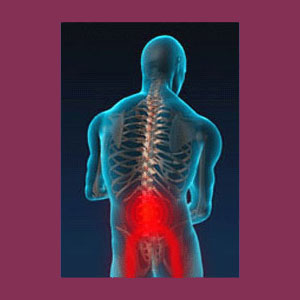
Scoliosis sciatica can occur due to compression of the lumbar and sacral nerve roots in the lower back or compression of the spinal cord virtually anywhere in the vertebral column. Sciatica is a set of symptoms that has a reputation as being torturous, chronic and virtually impossible to resolve. However, when sciatica is caused by scoliosis, at least the patient knows why they have pain and will even enjoy the possibility of a real cure if they can address the underlying curvature causing the current expression.
Sciatica is actually the proper name for buttocks, leg and/or foot symptoms that are caused by compression or chemical irritation of the nerve roots L4 through S3 in the lower spine. Pseudo-sciatica is the proper name for similar symptomatic expressions that are caused by some other means, such as cervical spinal stenosis, piriformis syndrome or sacroiliac joint issues. During this essay, we detail both scoliosis-related sciatica and pseudo-sciatica.
This discussion focuses on the relationship between scoliosis and sciatica. We will detail how scoliosis can directly cause or contribute to sciatica, as well as how the condition can be resolved using targeted therapy.
What is Scoliosis Sciatica?
Sciatica is never a diagnosis. Instead, it is a symptom set that is highly variable in location, expression, duration and severity, typically comprised of pain, tingling, weakness and/or numbness in the buttocks, hip, leg or foot. Range of motion and physical functionality in the legs is usually curtailed and uncomfortable.
Sciatica can be unilateral, affecting just one side of the body, or might be bilateral, affecting both sides. When the expression is bilateral, symptoms might occur in both legs together or alternate between legs. Additionally, bilateral symptoms might be identical in both legs or might differ in location, expression, duration and/or severity. It is obvious that sciatica is a highly-specific and incredibly diverse pain syndrome.
Less common symptoms of sciatica include incontinence of bladder and/or bowels. Some patients suffer sexual dysfunction. Neurological deficits are possible, with drop foot being the most often observed by neurologists.
Scoliosis Sciatica and Pseudo-Sciatica Causes
Scoliosis that exists in the lumbar spine can misalign the central spinal canal, as well as the neuroforaminal openings. In cases of neural foraminal stenosis, the openings facing into the concave portion of the curvature usually suffer the most marked reduction in patency. Likewise, scoliosis anywhere in the spine can also misalign the central canal, especially when the curvature involves dramatic changes in lordosis, kyphosis and vertebral rotation, as well.
Misalignments in the central canal tend to reduce the patency of the vertebral canal space through which the spinal cord and the cauda equina traverse. Other forms of central spinal stenosis are also likely to exist at the same location as the curvature, further reducing the effective size of the central canal. In the neck, cervical stenosis is commonplace and can lead to spinal cord compression that might enact pseudo-sciatica symptoms, along with a diversity of other possible expressions. This process can also occur in the thoracic spine, but it is less commonly seen. Spinal stenosis can also occur in the lumbar region in relation to a lower scoliotic curvature, potentially compressing the entire cauda equina in the central vertebral canal and potentially eliciting not only sciatica, but also cauda equina syndrome.
In other cases, lumbar and thoracolumbar scoliosis can reduce the patency of one or more of the foraminal spaces in the lower back, potentially compressing one or more nerve roots and leading to sciatica.
Theoretically, atypical spinal curvature can also contribute to alternate forms of pseudo-sciatica, as well, since the expressed functional and postural changes of scoliosis might affect the sacroiliac joint or piriformis muscle, both of which have the potential to create sciatica-type symptoms as a secondary consequence of the spinal curvature.
It should be noted that both sciatica and pseudo-sciatica have many, many possible causes and can exist completely coincidentally in scoliosis patients. Just because scoliosis is present certainly does not mean that the curvature is responsible for the current sciatica suffering. In fact, it is rare for scoliosis to cause sciatica, but it can happen and should always be considered during proper diagnostic evaluation of contributory factors.
Scoliosis Sciatica Treatment
If scoliosis is verified as the direct source of spinal cord or spinal nerve compression, usually the only definitive form of treatment is surgical intervention. In mild cases, the scoliosis might be left untreated and surgical efforts will focus on simply enlarging the spinal canal using laminectomy, or increasing the patency of the neural foramina using foraminotomy and/or laminectomy. In more severe cases of scoliosis, the only viable treatment path is typically large-scale spinal fusion to reduce the severity of the curvature and restore patency to the compressed canal spaces.
Pseudo-sciatica caused by the piriformis muscle or sacroiliac joints due to functional or postural changes associated with scoliotic curvatures might be easily treated with nonsurgical methods of care, such as exercises, stretches, injections or other forms of therapy.
Since sciatica is such a variable pain syndrome, diagnosis of the true cause can be an extremely challenging medical undertaking. Misdiagnosis is rampant and patients often suffer for extended timelines of many years with severe symptoms. We detail sciatica conditions in unrivaled detail on our website Sciatica-Pain.Org and highly recommend readers learning more about the condition on this comprehensive, free internet resource.





